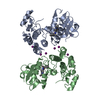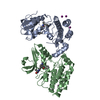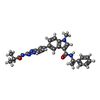[English] 日本語
 Yorodumi
Yorodumi- PDB-7ydx: Crystal structure of human RIPK1 kinase domain in complex with co... -
+ Open data
Open data
- Basic information
Basic information
| Entry | Database: PDB / ID: 7ydx | ||||||
|---|---|---|---|---|---|---|---|
| Title | Crystal structure of human RIPK1 kinase domain in complex with compound RI-962 | ||||||
 Components Components | Receptor-interacting serine/threonine-protein kinase 1 | ||||||
 Keywords Keywords | TRANSFERASE / RIPK1 / kinase / complex / inhibitor | ||||||
| Function / homology |  Function and homology information Function and homology informationripoptosome assembly / positive regulation of miRNA processing / positive regulation of interleukin-6-mediated signaling pathway / ripoptosome assembly involved in necroptotic process / death domain binding / peptidyl-serine autophosphorylation / ripoptosome / Defective RIPK1-mediated regulated necrosis / Microbial modulation of RIPK1-mediated regulated necrosis / TRIF-mediated programmed cell death ...ripoptosome assembly / positive regulation of miRNA processing / positive regulation of interleukin-6-mediated signaling pathway / ripoptosome assembly involved in necroptotic process / death domain binding / peptidyl-serine autophosphorylation / ripoptosome / Defective RIPK1-mediated regulated necrosis / Microbial modulation of RIPK1-mediated regulated necrosis / TRIF-mediated programmed cell death / Regulation by c-FLIP / CASP8 activity is inhibited / Dimerization of procaspase-8 / TLR3-mediated TICAM1-dependent programmed cell death / TNF signaling / programmed necrotic cell death / Caspase activation via Death Receptors in the presence of ligand / SARS-CoV-1-mediated effects on programmed cell death / positive regulation of macrophage differentiation / T cell apoptotic process / JUN kinase kinase kinase activity / necroptotic signaling pathway / NF-kB activation through FADD/RIP-1 pathway mediated by caspase-8 and -10 / death-inducing signaling complex / positive regulation of necroptotic process / RIP-mediated NFkB activation via ZBP1 / negative regulation of necroptotic process / positive regulation of tumor necrosis factor-mediated signaling pathway / death receptor binding / positive regulation of programmed cell death / positive regulation of programmed necrotic cell death / positive regulation of extrinsic apoptotic signaling pathway / TNFR1-induced proapoptotic signaling / RIPK1-mediated regulated necrosis / TRP channels / necroptotic process / response to tumor necrosis factor / positive regulation of execution phase of apoptosis / canonical NF-kappaB signal transduction / negative regulation of extrinsic apoptotic signaling pathway in absence of ligand / extrinsic apoptotic signaling pathway / TICAM1, RIP1-mediated IKK complex recruitment / signaling adaptor activity / IKK complex recruitment mediated by RIP1 / negative regulation of canonical NF-kappaB signal transduction / TNFR1-induced NF-kappa-B signaling pathway / Regulation of TNFR1 signaling / tumor necrosis factor-mediated signaling pathway / negative regulation of extrinsic apoptotic signaling pathway / positive regulation of interleukin-8 production / positive regulation of JNK cascade / Regulation of necroptotic cell death / protein catabolic process / positive regulation of non-canonical NF-kappaB signal transduction / positive regulation of NF-kappaB transcription factor activity / cellular response to growth factor stimulus / cellular response to hydrogen peroxide / positive regulation of protein phosphorylation / Ovarian tumor domain proteases / positive regulation of inflammatory response / positive regulation of reactive oxygen species metabolic process / positive regulation of tumor necrosis factor production / cellular response to tumor necrosis factor / positive regulation of neuron apoptotic process / protein autophosphorylation / response to oxidative stress / amyloid fibril formation / Potential therapeutics for SARS / endosome membrane / receptor complex / positive regulation of canonical NF-kappaB signal transduction / Ub-specific processing proteases / non-specific serine/threonine protein kinase / protein kinase activity / intracellular signal transduction / positive regulation of apoptotic process / inflammatory response / protein serine kinase activity / protein serine/threonine kinase activity / ubiquitin protein ligase binding / apoptotic process / positive regulation of gene expression / negative regulation of apoptotic process / protein-containing complex binding / protein homodimerization activity / positive regulation of transcription by RNA polymerase II / protein-containing complex / mitochondrion / ATP binding / identical protein binding / plasma membrane / cytosol / cytoplasm Similarity search - Function | ||||||
| Biological species |  Homo sapiens (human) Homo sapiens (human) | ||||||
| Method |  X-RAY DIFFRACTION / X-RAY DIFFRACTION /  SYNCHROTRON / SYNCHROTRON /  MOLECULAR REPLACEMENT / Resolution: 2.642 Å MOLECULAR REPLACEMENT / Resolution: 2.642 Å | ||||||
 Authors Authors | Zhang, L. / Wang, Y. / Li, Y. / Wu, C. / Luo, X. / Wang, T. / Lei, J. / Yang, S. | ||||||
| Funding support | 1items
| ||||||
 Citation Citation |  Journal: Nat Commun / Year: 2022 Journal: Nat Commun / Year: 2022Title: Generative deep learning enables the discovery of a potent and selective RIPK1 inhibitor. Authors: Li, Y. / Zhang, L. / Wang, Y. / Zou, J. / Yang, R. / Luo, X. / Wu, C. / Yang, W. / Tian, C. / Xu, H. / Wang, F. / Yang, X. / Li, L. / Yang, S. | ||||||
| History |
|
- Structure visualization
Structure visualization
| Structure viewer | Molecule:  Molmil Molmil Jmol/JSmol Jmol/JSmol |
|---|
- Downloads & links
Downloads & links
- Download
Download
| PDBx/mmCIF format |  7ydx.cif.gz 7ydx.cif.gz | 227.1 KB | Display |  PDBx/mmCIF format PDBx/mmCIF format |
|---|---|---|---|---|
| PDB format |  pdb7ydx.ent.gz pdb7ydx.ent.gz | 182.5 KB | Display |  PDB format PDB format |
| PDBx/mmJSON format |  7ydx.json.gz 7ydx.json.gz | Tree view |  PDBx/mmJSON format PDBx/mmJSON format | |
| Others |  Other downloads Other downloads |
-Validation report
| Summary document |  7ydx_validation.pdf.gz 7ydx_validation.pdf.gz | 925.5 KB | Display |  wwPDB validaton report wwPDB validaton report |
|---|---|---|---|---|
| Full document |  7ydx_full_validation.pdf.gz 7ydx_full_validation.pdf.gz | 936.8 KB | Display | |
| Data in XML |  7ydx_validation.xml.gz 7ydx_validation.xml.gz | 22.5 KB | Display | |
| Data in CIF |  7ydx_validation.cif.gz 7ydx_validation.cif.gz | 30.5 KB | Display | |
| Arichive directory |  https://data.pdbj.org/pub/pdb/validation_reports/yd/7ydx https://data.pdbj.org/pub/pdb/validation_reports/yd/7ydx ftp://data.pdbj.org/pub/pdb/validation_reports/yd/7ydx ftp://data.pdbj.org/pub/pdb/validation_reports/yd/7ydx | HTTPS FTP |
-Related structure data
| Related structure data |  4itjS S: Starting model for refinement |
|---|---|
| Similar structure data | Similarity search - Function & homology  F&H Search F&H Search |
- Links
Links
- Assembly
Assembly
| Deposited unit | 
| ||||||||
|---|---|---|---|---|---|---|---|---|---|
| 1 | 
| ||||||||
| Unit cell |
|
- Components
Components
| #1: Protein | Mass: 33468.730 Da / Num. of mol.: 2 / Mutation: C34A,C217A,C233A,C240A Source method: isolated from a genetically manipulated source Source: (gene. exp.)  Homo sapiens (human) / Gene: RIPK1, RIP, RIP1 / Production host: Homo sapiens (human) / Gene: RIPK1, RIP, RIP1 / Production host:  References: UniProt: Q13546, non-specific serine/threonine protein kinase #2: Chemical | #3: Chemical | ChemComp-IOD / #4: Water | ChemComp-HOH / | Has ligand of interest | Y | |
|---|
-Experimental details
-Experiment
| Experiment | Method:  X-RAY DIFFRACTION / Number of used crystals: 1 X-RAY DIFFRACTION / Number of used crystals: 1 |
|---|
- Sample preparation
Sample preparation
| Crystal | Density Matthews: 2.29 Å3/Da / Density % sol: 46.38 % |
|---|---|
| Crystal grow | Temperature: 277 K / Method: vapor diffusion, hanging drop Details: 0.25M ammonium iodide, 0.03M glycyl-glycyl-glycine, 23% polyethylene glycol (PEG) 3350 |
-Data collection
| Diffraction | Mean temperature: 100 K / Serial crystal experiment: N |
|---|---|
| Diffraction source | Source:  SYNCHROTRON / Site: NFPSS SYNCHROTRON / Site: NFPSS  / Beamline: BL19U1 / Wavelength: 0.97852 Å / Beamline: BL19U1 / Wavelength: 0.97852 Å |
| Detector | Type: DECTRIS PILATUS3 X CdTe 1M / Detector: PIXEL / Date: Jan 3, 2021 |
| Radiation | Protocol: SINGLE WAVELENGTH / Monochromatic (M) / Laue (L): M / Scattering type: x-ray |
| Radiation wavelength | Wavelength: 0.97852 Å / Relative weight: 1 |
| Reflection | Resolution: 2.64→50 Å / Num. obs: 18712 / % possible obs: 100 % / Redundancy: 11.3 % / Biso Wilson estimate: 40.17 Å2 / Rmerge(I) obs: 0.071 / Net I/σ(I): 36 |
| Reflection shell | Resolution: 2.64→2.7 Å / Mean I/σ(I) obs: 2.167 / Num. unique obs: 873 / CC1/2: 0.781 |
- Processing
Processing
| Software |
| ||||||||||||||||||||||||||||||||||||||||||||||||||||||||||||||||||||||||||||||||||||||||||||||||||||||||||||||||||||||||||||||||||||||||||||||||||||||
|---|---|---|---|---|---|---|---|---|---|---|---|---|---|---|---|---|---|---|---|---|---|---|---|---|---|---|---|---|---|---|---|---|---|---|---|---|---|---|---|---|---|---|---|---|---|---|---|---|---|---|---|---|---|---|---|---|---|---|---|---|---|---|---|---|---|---|---|---|---|---|---|---|---|---|---|---|---|---|---|---|---|---|---|---|---|---|---|---|---|---|---|---|---|---|---|---|---|---|---|---|---|---|---|---|---|---|---|---|---|---|---|---|---|---|---|---|---|---|---|---|---|---|---|---|---|---|---|---|---|---|---|---|---|---|---|---|---|---|---|---|---|---|---|---|---|---|---|---|---|---|---|
| Refinement | Method to determine structure:  MOLECULAR REPLACEMENT MOLECULAR REPLACEMENTStarting model: 4ITJ Resolution: 2.642→48.765 Å / SU ML: 0.39 / Cross valid method: THROUGHOUT / σ(F): 1.35 / Phase error: 29.66 / Stereochemistry target values: ML
| ||||||||||||||||||||||||||||||||||||||||||||||||||||||||||||||||||||||||||||||||||||||||||||||||||||||||||||||||||||||||||||||||||||||||||||||||||||||
| Solvent computation | Shrinkage radii: 0.9 Å / VDW probe radii: 1.11 Å / Solvent model: FLAT BULK SOLVENT MODEL | ||||||||||||||||||||||||||||||||||||||||||||||||||||||||||||||||||||||||||||||||||||||||||||||||||||||||||||||||||||||||||||||||||||||||||||||||||||||
| Displacement parameters | Biso max: 99.09 Å2 / Biso mean: 42.1556 Å2 / Biso min: 16.35 Å2 | ||||||||||||||||||||||||||||||||||||||||||||||||||||||||||||||||||||||||||||||||||||||||||||||||||||||||||||||||||||||||||||||||||||||||||||||||||||||
| Refinement step | Cycle: final / Resolution: 2.642→48.765 Å
| ||||||||||||||||||||||||||||||||||||||||||||||||||||||||||||||||||||||||||||||||||||||||||||||||||||||||||||||||||||||||||||||||||||||||||||||||||||||
| LS refinement shell | Refine-ID: X-RAY DIFFRACTION / Rfactor Rfree error: 0 / Total num. of bins used: 13
| ||||||||||||||||||||||||||||||||||||||||||||||||||||||||||||||||||||||||||||||||||||||||||||||||||||||||||||||||||||||||||||||||||||||||||||||||||||||
| Refinement TLS params. | Method: refined / Refine-ID: X-RAY DIFFRACTION
| ||||||||||||||||||||||||||||||||||||||||||||||||||||||||||||||||||||||||||||||||||||||||||||||||||||||||||||||||||||||||||||||||||||||||||||||||||||||
| Refinement TLS group |
|
 Movie
Movie Controller
Controller


 PDBj
PDBj













